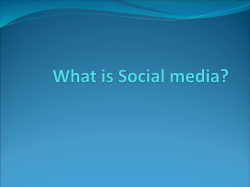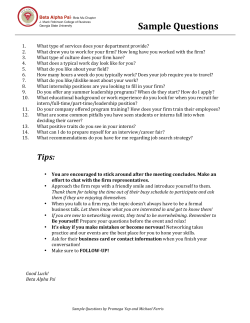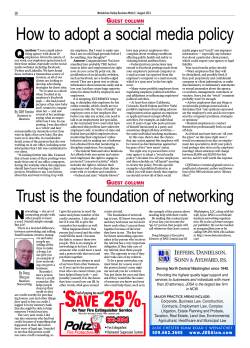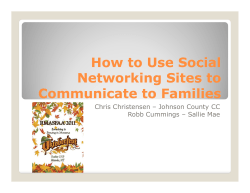
The Social Network Guys Aman Kewei Tenzin
The Social Network Guys Aman Kewei Tenzin • It is the way the 21st century communicates today. •It is the grouping of individuals into specific groups, like small rural communities or a neighborhood subdivision •Social Media includes Web-based and mobile technologies used to turn communication into easiest way. 2. Social media technologies take on many different forms such as: 1. magazine 2. Internet forums 3. weblogs 4. social blogs 5. micro blogging 6. wikis 7. podcasts 8. photographs or pictures, video, rating and social bookmarking. • • • • • • 1. Collaborative projects (e.g., Wikipedia) 2. Blogs and Microblogs (e.g., Twitter) 3. Content communities (e.g., YouTube) 4. Social Networking Sites (e.g., Facebook), 5. Virtual Game Worlds (e.g., World of Warcraft) 6. Virtual Social Worlds (e.g. Second Life). facebook’s World From infographiclabs.com/ From vincos.it Updates (Updates and post status including how you’re feeling on social networking sites) Photos (Sharing photos is a common way, many people use the mobile devices to sharing photos in seconds) Events (Social networking changed the way society gets its news, We can easy to share an event, and grouping together) Location (Sharing your Location using mobile devices) The “Like” Button (Many people use facebook’s “Like” to promote their websites and updates) Marketing ( Some of the business may offer a discount on a product for people who “Like”, or “Follow” their business pages) From Briansolis.com The popularity of social networking sites more than quadrupled from 2005 to 2009. Facebook reports approximately 90 million users in the US and 300 million active users worldwide (as of Sep. 15, 2009) MySpace more than 32 million US users and 130 million worldwide (as of Aug. 4, 2009) Twitter has an estimated 54 million users worldwide (as of Oct. 13, 2009). 35% of adults and 65% of teens in America who use the Internet have profiles on social networking sites. 845 million(active December 31, 2011) 1.5 Billion Social Network Users Worldwide by 2012 1. Social networking sites allow people to create new relationships and reconnect with friends and family. Increased communication, even online, strengthens relationships 2. Social networking sites allow for creative expression in a new platform. They provide free messaging, blogging, photo storage, games, event invitations, and many other services to anyone with access to a computer and the Internet. 3. 60 million Americans received help with major life issues (changing jobs, finding a new place to live, buying a car, and caring for someone with an illness) from people in their social networks in 2006. These people said social networking sites helped them connect with friends 4. 59% of students report that they use social networking sites to discuss educational topics including career and college planning. 50% use the sites to talk about school assignments. parents and teachers say that using these sites helps students improve their reading, writing, and conflict resolution skills, learn to express themselves more clearly, and meet new and different kinds of students from around the world. Pros 5. Social media can be a powerful tool for social change 6. Social media sites are expanding from general interest to more specific uses that benefit society 7. Social Networks have been of great assistance in spreading revolution into many parts of the world such as the revolution in Egypt and Tunisia. 8. Social Networks like Twitter give people fast real time news on important events occurring anywhere near your home to somewhere on the other side of the world. 1. Social networking sites entice people to spend more time online and less time interacting face-to-face. 2. Teens growing up with these sites may not be aware that the information they post is public and that photos and text can be retrieved even after deletion. Consequences from over-sharing personal information include vulnerability to sexual or financial predators and lost job opportunities 3. Social networking sites have no way to verify that people are who they claim to be, leaving people vulnerable to solicitations from online predators who are able to mask their true identities. 4. Social networking sites make cyber bullying, a type of bullying that occurs online, easier and more public than 5. The use of social networking sites can cause personality and brain disorders in children, such as the inability to have real conversations, limited attention spans, a need for instant gratification, Attention-Deficit Hyperactivity Disorder (ADHD), and self-centered personalities. spear phishing, social engineering, spoofing, and web application attacks attempt to steal a person's identity. Such attacks are often successful due to the assumption of being in a trusting environment social networks create. Security and privacy related to social networking sites are fundamentally behavioral issues, not technology issues. The more information a person posts, the more information becomes available for a potential compromise by those with malicious intentions. People who provide private, sensitive or confidential information about themselves or other people, whether knowingly or unknowingly, pose a higher risk to themselves and others. $4,000 $3,710 $3,500 $3,000 $2,500 $2,000 $1,970 Revenue 2010 (in million) Revenue 2011 (in million) $1,500 $1,000 $522 $500 $140 $150 $243 $288 $109 $Facebook Twitter Linkedin Myspace The bulk of these revenue will go towards • Linked in will earn 3% of the global SN revenue. •Linkedin ad tripled but still stagnant growth $45.00 $40.00 $35.00 in Billions $30.00 $25.00 $20.00 Social Network ad revenue Total US online spending $15.00 $10.00 $5.00 $2009 2010 2011 years 2012 2013 Apple CEO Steve Jobs holds venture capital investment check http://www.scoop.it/t/infographies?page=6 http://infographiclabs.com/infographic/theworld-of-facebook/ http://en.wikipedia.org/wiki/Social_media http://www.ehow.com/info_10066464_nineways-use-social-media.html http://vincos.it/world-map-of-socialnetworks/ WWW.marketer.com
© Copyright 2025





















